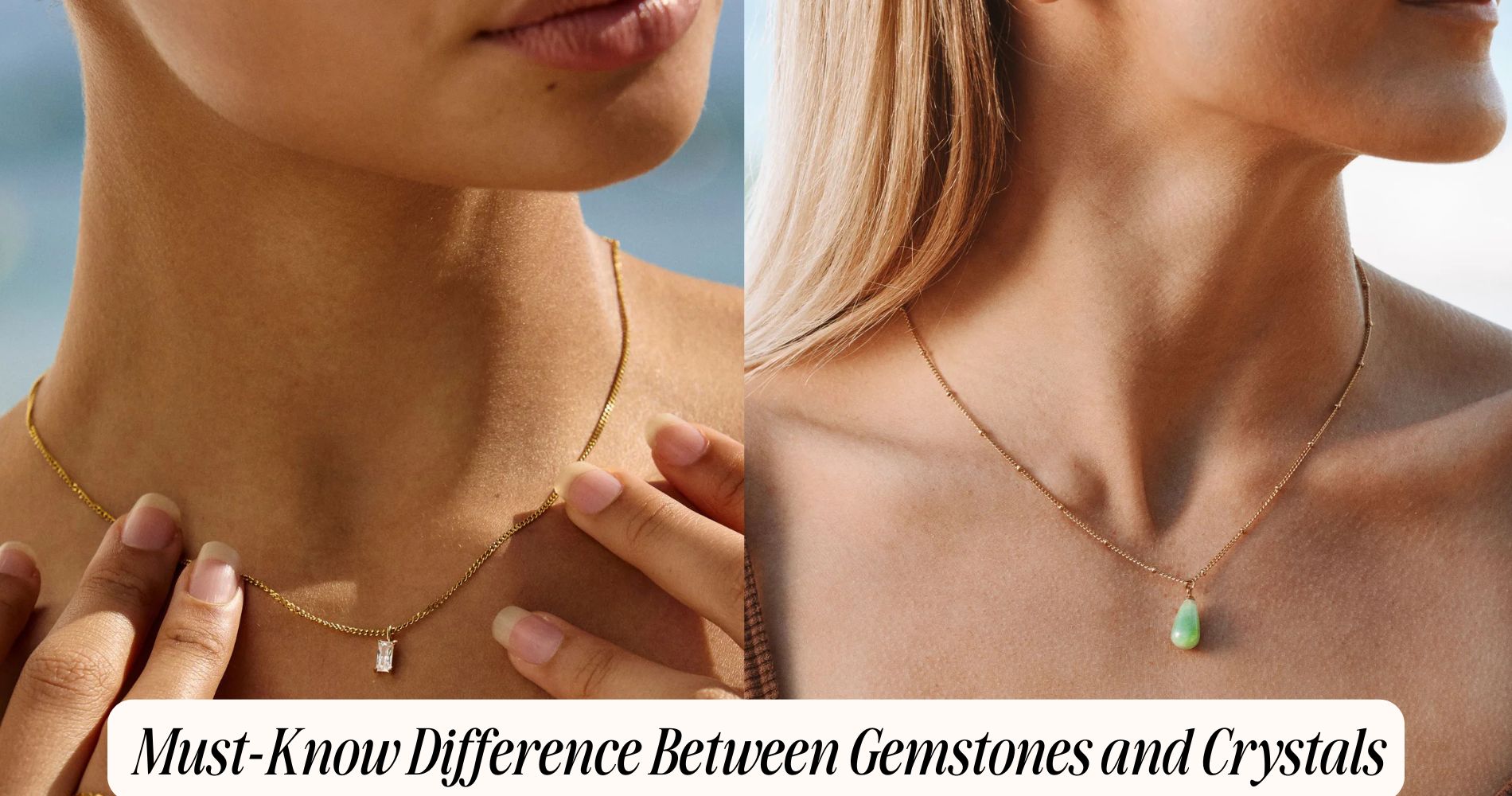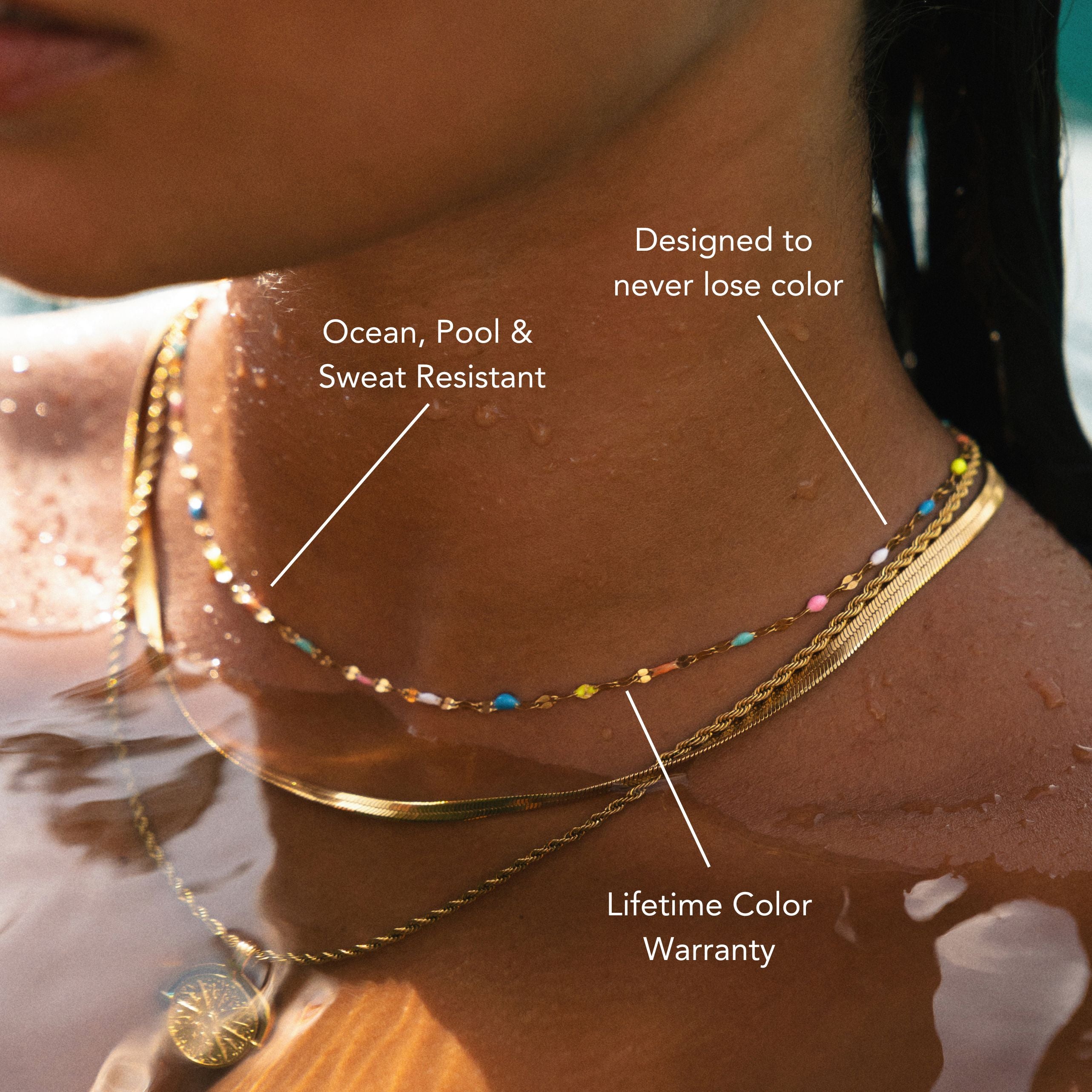
Must-Know Difference Between Gemstones and Crystals
Understanding the difference between gemstones and crystals can deepen your appreciation for these captivating natural wonders. Gemstones, like diamonds and sapphires, are polished minerals cherished for their rarity and beauty, often featured in fine jewelry. Crystals, however, are naturally formed solids with a precise atomic structure, shaped by various geological processes. While gemstones show a range of colors due to impurities, crystals usually maintain consistent hues due to their uniform composition. Exploring these distinctions reveals their unique properties and roles in both jewelry and healing. Discover how these elements shine in our Everyday Gold Jewelry collection, where nature’s beauty is transformed into wearable art.
Definitions of Gemstones
Gemstones are defined as naturally occurring minerals or rocks that are cut and polished for use in jewelry and ornamentation. To understand gemstones, you need to recognize their classifications, which typically include precious and semi-precious categories.
Precious gemstones, like diamonds, rubies, sapphires, and emeralds, are valued for their rarity and durability. Semi-precious stones encompass a broader range, including amethyst, aquamarine, and garnet, which, while beautiful, don't hold the same market value as their precious counterparts.
When it comes to gemstone sources, you should know that these minerals come from various geographical locations around the world. For instance, diamonds primarily originate from countries like Russia and Botswana, while sapphires are often sourced from Sri Lanka and Australia.
Understanding these sources is essential, as the origin can affect both the quality and value of the gemstone. In addition, factors such as color, clarity, cut, and carat weight play significant roles in determining a gemstone's final classification and market appeal.
Definitions of Crystals
Crystals are defined by their orderly, repeating atomic structures, which give them distinct shapes and properties.
You'll find that the distinction between natural and synthetic crystals greatly impacts their applications across various industries.
Understanding these characteristics is essential for recognizing their uses in both decorative and functional contexts.
Crystal Structure Characteristics
The intricate nature of crystal structures is defined by their ordered arrangement of atoms, ions, or molecules. This orderly configuration results in unique geometric patterns that determine the crystal's external shape and internal properties.
You'll notice that crystals exhibit distinct symmetry, which plays a critical role in their classification.
Crystals can present a range of color variations due to the presence of different elements or impurities within their structure. For instance, trace amounts of chromium can impart a rich green hue to emeralds, while iron can cause quartz to take on a smoky tone.
Clarity factors are equally important, as they affect the crystal's transparency and brilliance. Internal flaws, known as inclusions, may disrupt light paths, influencing how light interacts with the material.
A high clarity factor typically enhances a crystal's value, while noticeable inclusions can detract from its aesthetic appeal.
Natural vs. Synthetic Crystals
Understanding the distinction between natural and synthetic crystals is fundamental to grasping their definitions and applications.
Natural crystals form through geological processes over time, exhibiting unique characteristics shaped by their environment. You'll find that these crystals often contain impurities, which can enhance their beauty and authenticity.
In contrast, synthetic crystals are manufactured through human intervention, using processes that replicate their natural counterparts. These synthetic origins allow for the production of crystals with specific properties and in desired colors, often at a lower cost.
While both types can share similar physical and chemical properties, their formation processes set them apart.
You should also consider natural enhancements, which involve treatments applied to natural crystals to improve their appearance, such as heat treatment or dyeing. These enhancements can sometimes blur the lines between natural and synthetic, making it essential to evaluate the source and treatment of a crystal.
Uses and Applications
Applications of crystals span a wide range of fields due to their unique physical and chemical properties. In the domain of healing, crystals are renowned for their purported healing properties, with practitioners utilizing them in various holistic therapies. You might encounter quartz or amethyst in practices aimed at promoting emotional balance and physical well-being. While scientific evidence for these claims varies, the popularity of crystal healing continues to grow.
On the industrial side, crystals play a critical role in technology and manufacturing. For instance, quartz crystals are essential in the production of oscillators and resonators used in electronic devices. Their precise frequency stability makes them invaluable in communication technologies.
Additionally, crystals like silicon are fundamental in semiconductor applications, underpinning modern electronics. Moreover, the optical properties of crystals lend themselves to applications in lasers and optical devices.
You'll find that the versatility of crystals is evident in both healing practices and industrial applications. Understanding these uses helps you appreciate the multifaceted nature of crystals and their significance in various sectors.
Formation Processes
When examining the formation processes of gemstones and crystals, you'll find significant distinctions between natural and synthetic origins.
Understanding the geological formation methods and the specific growth conditions involved is essential in differentiating these two categories.
Natural vs. Synthetic Origins
Natural and synthetic origins represent two distinct pathways through which gemstones and crystals can form, each with unique characteristics and implications.
When you consider natural origins, you're looking at materials that develop through geological processes over millions of years. These processes often involve extreme heat and pressure, resulting in unique inclusions and variations that contribute to the stone's value and appeal. You can expect natural stones to exhibit imperfections, which serve as identifiers of their authenticity.
On the other hand, synthetic origins refer to materials created in a laboratory setting, mimicking natural conditions to produce gemstones and crystals.
While synthetic stones may achieve the same chemical composition as their natural counterparts, they often lack the unique inclusions and environmental history. This can lead to a more uniform appearance, which some buyers may find appealing for specific applications, such as jewelry.
Geological Formation Methods
Understanding the origins of gemstones and crystals naturally leads to exploring their geological formation methods, which play a significant role in determining their characteristics.
Gemstones typically emerge from three main geological processes: igneous formations, sedimentary processes, and metamorphic changes.
In igneous formations, molten rock solidifies, allowing minerals to crystallize through cooling and solidification. The rate of cooling affects the crystal size and structure, influencing the gemstone's overall properties.
Sedimentary processes involve the accumulation and compaction of mineral particles over time, often leading to unique mineral associations that can give rise to various crystals.
Metamorphic changes occur when existing rocks undergo transformation due to tectonic influences, heat, and pressure. This process can enhance the crystalline structure of minerals, resulting in valuable gemstones.
Crystallization techniques also play an essential role; for example, hydrothermal activity can lead to the formation of crystals as mineral-rich fluids cool and precipitate.
Each of these formation methods is governed by specific environmental conditions, which ultimately shape the characteristics and rarity of the gemstones and crystals you encounter.
Understanding these processes deepens your appreciation for their natural beauty and complexity.
Growth Conditions and Factors
Growth conditions and factors greatly influence the formation processes of gemstones and crystals. You'll find that environmental influences play a pivotal role in determining the characteristics and quality of these minerals. For instance, the presence of specific elements, the pH of the surrounding environment, and the availability of water can remarkably affect the crystallization process.
Temperature variations also serve as critical factors. In high-temperature environments, such as volcanic activity, minerals can form rapidly, often leading to larger crystals and distinctive patterns. Conversely, in cooler settings like deep underground deposits, the slow cooling process allows for more intricate and well-defined crystal structures to develop over extended periods.
Furthermore, pressure conditions can alter how these minerals grow. In high-pressure environments, you may see denser crystal formations, which are often more durable and sought after in the gemstone market.
Understanding these growth conditions and factors not only enhances your appreciation of gemstones and crystals but also assists in identifying their origins and potential value. By analyzing these elements, you can make informed decisions whether you're a collector, jeweler, or simply an enthusiast.
Physical Properties
When comparing gemstones and crystals, you'll notice several distinct physical properties that set them apart.
Gemstones, typically formed through geological processes, exhibit a range of color variations due to the presence of trace elements and their crystalline structure. For instance, sapphires can occur in various colors, not just blue, due to different mineral inclusions.
Conversely, crystals often display a more consistent color due to their more uniform composition, primarily reflecting their elemental makeup.
Hardness scales, such as the Mohs scale, further differentiate these two categories. Gemstones are generally rated higher on this scale, indicating greater resistance to scratching and wear.
For example, diamonds, a type of gemstone, rank a perfect 10, while many common crystals, like quartz, rank at a 7. This difference in hardness not only affects durability but also influences their application in various settings.
Understanding these physical properties helps you appreciate the unique characteristics of gemstones and crystals, aiding you in making informed choices whether for collection or study.
Uses in Jewelry
Gemstones and crystals play pivotal roles in the jewelry industry, each offering distinct aesthetic and functional attributes. Gemstones, often prized for their rarity and brilliance, serve as the focal point in many designs. Their hardness and durability make them ideal for everyday wear, aligning with current jewelry trends that favor lasting quality.
You'll find diamonds, sapphires, and emeralds prominently featured in engagement rings and statement pieces, where their visual impact captivates the eye.
On the other hand, crystals, while generally more abundant, provide unique textures and colors that enhance jewelry designs. Their versatility allows for innovative design techniques, such as layering and mixing materials, which can create eye-catching contrasts.
Crystals are often used in bohemian styles, aligning with trends that embrace individuality and organic aesthetics.
When incorporating both gemstones and crystals into your jewelry collection, consider how each element complements the overall design. Whether you're drawn to the opulence of gemstones or the playful elegance of crystals, understanding their distinct properties will elevate your choices and align with contemporary jewelry trends.
Cultural Significance
Throughout history, gemstones and crystals have held profound cultural significance across various societies. You'll find that many cultures attribute specific meanings and powers to these natural elements, serving as symbols of status, protection, and spiritual connection.
For instance, ancient Egyptians revered lapis lazuli for its deep blue hue and believed it provided protection in the afterlife, showcasing its historical significance.
In contrast, crystals like quartz have been used in various traditions for their purported healing properties. This cultural symbolism extends beyond mere ornamentation; it reflects deep-rooted beliefs and practices that connect individuals to their heritage and the cosmos.
In some cultures, specific gemstones are worn during rituals to enhance spiritual energy or signify important life events, such as marriage or birth.
You'll also notice that gemstones and crystals often serve as tokens of power or wealth, influencing social hierarchies throughout history. For example, crowns adorned with precious stones have symbolized royal authority in numerous civilizations.
This intertwining of gemstones and crystals with cultural practices highlights their intricate role in shaping human experiences and beliefs, affirming their enduring importance beyond aesthetic appeal.
Value Assessment
Evaluating the value of gemstones and crystals involves multiple factors, including rarity, quality, and market demand. Rarity plays a critical role; the fewer the available specimens, the higher the potential value.
Quality is assessed through characteristics such as color, clarity, cut, and carat weight for gemstones, while crystals are valued based on their formation, clarity, and uniqueness.
Valuation methods vary considerably. For gemstones, appraisers often employ standardized grading systems like the GIA scale, which assesses the four Cs. In contrast, crystals may be evaluated based on aesthetic appeal and metaphysical properties, which can be subjective.
Market trends also heavily influence value. A gemstone that's currently in vogue can see its price skyrocket, while crystals that align with current wellness trends may gain appreciation. Awareness of these trends is essential for making informed decisions about buying or selling.
Understanding these factors helps you navigate the complexities of value assessment, allowing you to make educated choices whether you're investing, selling, or simply collecting.
Always stay updated on market dynamics to guarantee your evaluations are accurate and relevant.
Collecting Tips
When you're ready to start collecting gemstones and crystals, having a strategic approach can greatly enhance your experience and investment potential.
First, define your collecting strategies. Decide whether you want to focus on specific types, colors, or origins. This focus helps you develop expertise and can lead to better purchasing decisions.
Next, establish a budget that accommodates both acquisition and maintenance costs. High-quality specimens can be an investment, so prioritize quality over quantity.
Attend gem shows, auctions, and online marketplaces to find reputable sellers. Always verify the authenticity and quality through certificates or appraisals.
Once you've acquired your collection, consider displaying your pieces effectively. Use display techniques that protect and showcase your gemstones and crystals, such as UV-protective glass cases or shadow boxes.
Organize your collection by type, color, or size to enhance visual appeal and provide easy access for study or appreciation.
Popular Examples
Many collectors gravitate toward a select few gemstones and crystals that stand out due to their beauty, rarity, or unique properties. Among the famous gemstones, diamonds are often considered the epitome of luxury, prized for their hardness and brilliance.
Rubies, with their deep red hue, symbolize passion and are sought after for both their aesthetic and investment value. Sapphires, available in various colors but most recognized in blue, are revered for their durability and historical significance.
On the crystal side, amethyst is a popular healing crystal, known for its calming properties and ability to enhance intuition. Clear quartz, often called the "master healer," is valued for its versatility and amplification of energy.
Rose quartz, associated with love and emotional healing, attracts many for its gentle vibes.
Understanding these popular examples allows you to better appreciate the distinctions and applications of gemstones and crystals. Whether you're drawn to the allure of famous gemstones or the metaphysical benefits of healing crystals, knowing their unique characteristics can enhance your collecting experience.
Frequently Asked Questions
Are Gemstones and Crystals Both Considered Minerals?
Yes, both gemstones and crystals fall under mineral classification. They're natural formations, composed of specific chemical compounds and atomic structures. Understanding their classification helps you appreciate their unique properties and uses in various applications.
Can Gemstones Be Synthetic or Lab-Created?
Yes, gemstones can be synthetic or lab-created. Synthetic gemstones are chemically identical to natural ones, while lab-created crystals are manufactured using specific techniques, often mimicking natural processes to produce visually appealing and durable alternatives.
How Do I Clean My Gemstones and Crystals?
To clean your gemstones and crystals, use gentle cleaning techniques with safe materials like mild soap and water. Avoid harsh chemicals or abrasive tools, as they can damage the surface and integrity of your stones.
Do Gemstones and Crystals Have Healing Properties?
Yes, gemstones and crystals are believed to possess healing energy and metaphysical properties. You can use them for emotional balance, stress relief, and overall well-being, but individual experiences may vary depending on personal beliefs and intentions.
How Can I Tell if a Gemstone Is Real?
To determine gemstone authenticity, examine its clarity, color, and weight. Use tools like a loupe or refractometer. Be cautious of inclusions and overly perfect stones; these often indicate identifying fake gemstones. Trust your instincts and research.
Conclusion
In conclusion, understanding the distinctions between gemstones and crystals enhances your appreciation for both. While gemstones are often valued for their rarity and beauty, crystals possess unique structural properties that contribute to their formation and uses. Recognizing these differences can inform your choices in jewelry, collection, and investment. As you explore the world of gemstones and crystals, keep these key factors in mind to make informed decisions and deepen your engagement with these fascinating materials.
























Leave a comment
This site is protected by hCaptcha and the hCaptcha Privacy Policy and Terms of Service apply.